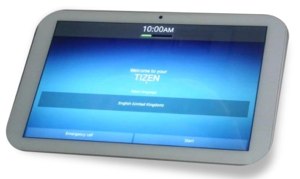The Tizen-based tablet announced this week by Japan-based Shisutena is the first formally announced Tizen device. The surprisingly powerful slate suggests not only that Tizen is about more than just Samsung smartphones, but that the mobile Linux OS is not afraid to go head to head with Android on the high end.
Shisutena appears to be a partner or division of Japan’s Systena, which ran the same press release republished by Hermitage Akihabara and later reported on by Liliputing.
 The unnamed Tizen device matches the specs of a high-end Android tablet, featuring a 1.4GHz, quad-core Cortex-A9 processor backed up with 2GB of RAM and 32GB of flash. The Shisutena tablet also features a 10.1-inch display with impressive 1920 x 1200 resolution. Other features include WiFi, a microSD slot, and both 2-megapixel and 0.3-megapixel cameras.
The unnamed Tizen device matches the specs of a high-end Android tablet, featuring a 1.4GHz, quad-core Cortex-A9 processor backed up with 2GB of RAM and 32GB of flash. The Shisutena tablet also features a 10.1-inch display with impressive 1920 x 1200 resolution. Other features include WiFi, a microSD slot, and both 2-megapixel and 0.3-megapixel cameras.
Shisutena says it will show the tablet at a trade show on Oct. 23, and that it is prepping an in-vehicle infotainment (IVI) product using Tizen. Japanese mobile operator and Tizen backer NTT DoCoMo will sell the device, according to a report by TizenExperts.
Until this week, I comfortably assumed that Samsung would be the first to announce Tizen products. I also assumed, a bit less comfortably, that the first products would have mid-range specs, aimed at advanced emerging markets like China.
Tizen Devices Aim High
At the Tizen Developers Conference in late May, Samsung said its first Tizen phone would appear “very soon.” That same week images emerged of Samsung GT-I8805 and GT-I8800 smartphones running Tizen 2.1 on a Cortex-A9 processor, and offering modest 1280 x 720 resolution. Earlier this month the phones resurfaced on the Samsung test-center website.
The only other vendor to publicly commit to Tizen is Huawei. Meanwhile, carriers NTT DoCoMo and Orange have promised Tizen smartphone launches in 2013, but like Huawei and Samsung, they have offered no details.
The Shisutena tablet’s supercharged specs may be an anomaly, reflective of its focus on Japan, which like Korea, has a thriving high-end market. It’s may also be the tablet won’t ship until 2014, at which point faster tablets running Cortex-A15 processors like the Exynos 5, Tegra 4, or Snapdragon 800 will define the high end even in China. Then again, Tizen may be aiming higher than we thought.
Officially, Tizen supports smartphones, tablets, netbooks, IVI, and Smart TV systems, but so far the action has been in smartphones and IVI. Shortly after the Tizen conference, however, Tizen developer Arnaud Dupuis posted a video of a Tizen port to the Android-based Nexus 7 tablet. On the netbook front, meanwhile, Tizen backer Intel used the conference to demo a preview version of Tizen 3.0 running on a laptop via a GNOME shell.
No doubt, Intel would like to see Tizen loaded onto tablets running its upcoming Silvermont architecture Bay Trail system-on-chips. The chipmaker may also have Tizen in mind for the upcoming mobile versions of its 4th Generation Core (“Haswell”) processors, which target high-end Android and Windows tablets. Recently, an Intel staffer leaked images of a home-grown smartphone UI overlay called “Obsidian” designed for Tizen.
“Most Notable Player” Tizen Plays it Close to the Vest
Earlier this month ABI Research projected that Tizen will be the “most notable player” among emerging Linux-based mobile platforms. No specific projections were supplied except for an estimate that 65 percent of Tizen’s future installed base will be in the Asia-Pacific region.
It’s not surprising that Tizen is the de facto leader. It’s backed by Android potentate Samsung and CPU leader Intel, as well as the Linux Foundation and an extensive list of mobile carriers. Still, because Tizen vendors are playing it close to the vest, the platform has been far less visible than its similarly HTML5-based rival Mozilla’s Firefox OS, despite having been launched almost a year before.
That could change in a hurry. Although some MeeGo veterans may fear that Samsung could “pull a Nokia” and abandon the platform, it’s more likely the tech giant will pour a ton of money into the launch. The recent announcement of a Tizen App Challenge featuring over $4 million in prizes suggests the funding we might expect to see.
Mozilla and partners like ZTE have less cash to throw around, but Firefox OS got a major boost this month when Chinese ODM manufacturer Foxconn (Hon Hai Precision Industry) demonstrated a Firefox OS tablet. Foxconn said it was working with Mozilla on other devices, including smart TVs and digital signage systems. Last week, the Taipei Times reported that Foxconn will hire up to 3,000 engineers to work on Firefox OS.
While Tizen and Firefox OS announced extensive carrier support months ago, the other two mobile Linux players — Canonical and Jolla – announced their first carriers only this month. Finland-based DNA will carry the first Jolla Sailfish OS phones by the end of the year. Canonical had no similar commitments for next year’s Ubuntu Touch devices, but announced an eight-member “Carrier Advisory Group” (CAG) that will influence Ubuntu for Phones.
Canonical is also developing an Ubuntu for Tablets platform, but the first slates aren’t expected until late 2014. By then there should be a number of other Linux-based tablets available that don’t sport a little robot on the box.


